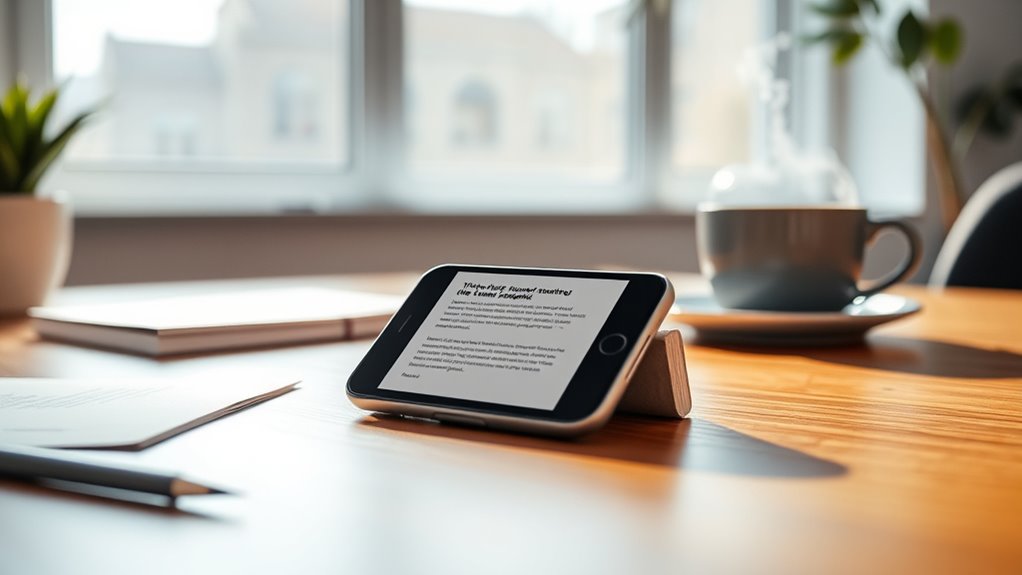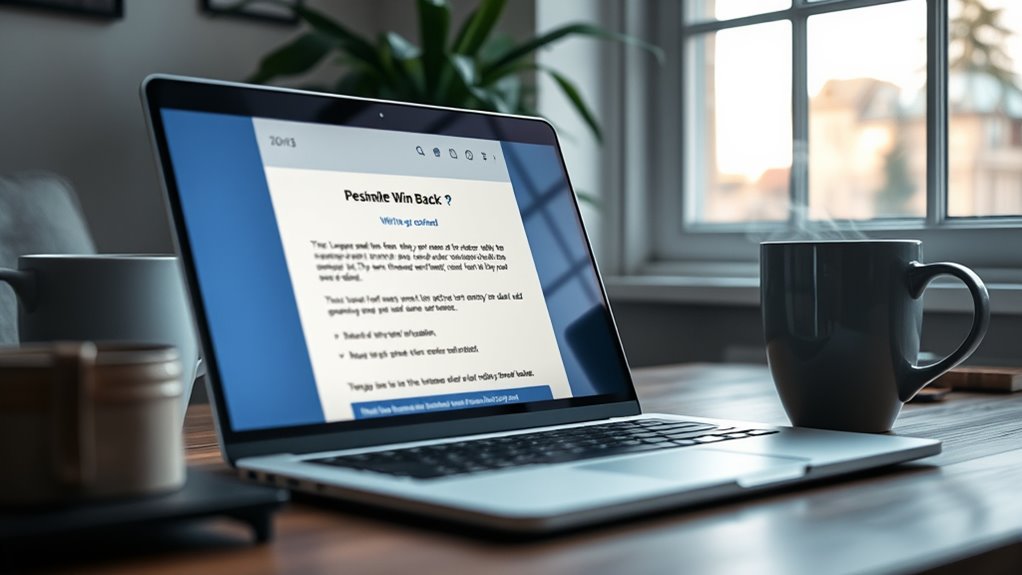To craft win-back emails that don’t feel desperate, focus on timely, personalized messages that show genuine understanding of your customers’ needs. Highlight new features or improvements based on their feedback, and offer valuable incentives like discounts or free trials without pressuring them. Keep your tone friendly, empathetic, and respectful, emphasizing support rather than urgency. If you want to learn how to make your outreach more effective without sounding pushy, here’s what you should explore next.
Key Takeaways
- Personalize messages based on customer behavior and preferences to show genuine interest without sounding pushy.
- Use empathetic language that acknowledges possible frustrations while offering support and solutions.
- Highlight new features, rewards, or offers that demonstrate ongoing value without urgent pressure.
- Send re-engagement emails at optimal times, such as mid-morning or early evening, avoiding inopportune moments.
- Test and refine subject lines, content, and offers continuously using data to ensure a balanced, non-desperate approach.
Understanding Why Customers Leave

Have you ever wondered why customers abandon your service? Understanding customer psychology is key to uncovering their reasons. One effective tool is an exit survey, which asks departing customers for honest feedback. These surveys reveal common pain points, frustrations, or unmet expectations that lead to churn. By analyzing responses, you gain insight into what influences their decision to leave. Perhaps they found a better price elsewhere, or maybe your service didn’t meet their needs. Recognizing these patterns helps you identify areas for improvement. Remember, customers often don’t leave randomly—they leave because of specific experiences or perceptions. Conducting exit surveys allows you to gather actionable data, so you can address issues proactively and improve your service, reducing future abandonment.
Timing Your Re-Engagement Efforts

Timing is crucial when re-engaging customers who have abandoned your service, as reaching out too early or too late can diminish your chances of success. To maximize impact, consider seasonal trends that influence customer behavior, such as holidays or industry-specific busy periods. These trends can help you identify the best moments to send re-engagement emails. Additionally, understanding ideal send times—like mid-morning or early evening—ensures your message reaches customers when they’re most receptive. Monitoring engagement patterns over time allows you to refine your timing strategy further. Avoid bombarding customers at inopportune moments; instead, focus on sending thoughtfully timed emails aligned with seasonal and behavioral cues. Proper timing boosts your chances of reigniting interest and recovering abandoned service relationships, especially when combined with timely content updates that appeal to customer interests.
Personalization: Making It Relevant

While timing sets the stage for successful re-engagement, personalization makes your outreach truly compelling. You can achieve this by leveraging customer segmentation to group service‑abandoners based on their behaviors and preferences. Tailor your messages to address their specific needs, making each email feel relevant. Incorporate behavioral triggers—like recent activity or skipped steps—to personalize content further. For example, if someone abandoned during a trial, remind them of its benefits or offer a special incentive. This targeted approach shows you understand their unique situation, increasing the chances they’ll reconnect. Additionally, understanding investment assets such as gold coins or bars can help you discuss options that align with their interests or previous inquiries. Avoid generic messages; instead, focus on relevant details that resonate with each recipient, demonstrating genuine interest and making your win-back efforts feel less desperate and more considerate.
Crafting a Genuine and Respectful Message

To reconnect with service‑abandoners effectively, your message must come across as genuine and respectful. Show customer empathy by acknowledging their experience without judgment or pressure. Use a friendly, approachable tone that reflects your brand’s personality consistently, maintaining brand consistency in your language and style. Avoid sounding salesy or desperate; instead, focus on understanding their needs and offering support. Keep your message clear and straightforward, emphasizing that you value their relationship and want to help. Respect their space by giving them the option to re-engage on their terms. By being authentic and considerate, you build trust and increase the likelihood they’ll return willingly, not because they feel coerced. Recognizing the importance of customer retention can help guide your communication approach effectively.
Highlighting New or Improved Offerings

Introducing our latest offerings and improvements shows you we’re committed to meeting your evolving needs. By highlighting new features or enhancements, you demonstrate how we value your feedback and loyalty. A well-crafted win-back email can showcase our expanded loyalty program, offering better rewards for your continued support. Sharing updates based on customer feedback shows we listen and adapt to what matters most to you. Here’s a quick overview:
| Feature | Benefit | Status |
|---|---|---|
| Upgraded Rewards | More valuable loyalty perks | Now Available |
| New Service Options | More choices tailored to you | Recently Added |
| Customer Feedback | Shaping our improvements | Upfront & Transparent |
| Exclusive Offers | Special deals for returning members | Coming Soon |
| Enhanced Support | Faster, personalized assistance | Launching Soon |
This approach keeps your experience fresh and rewarding. Additionally, incorporating mindfulness techniques can enhance your overall engagement and satisfaction with our services.
Using Social Proof to Build Trust

Building trust with your audience becomes easier when you leverage social proof. Customer testimonials are a powerful form of social proof because they show real people who have had positive experiences with your service. Including testimonials in your win-back emails reassures your audience that others have benefited from returning. Highlight specific benefits or results customers achieved, as this adds credibility. When prospects see genuine feedback from satisfied customers, it reduces doubts and builds confidence in your offering. Authentic social proof demonstrates that your service delivers value, encouraging potential return without sounding pushy. Use brief, compelling testimonials that address common concerns or showcase success stories. This approach fosters trust naturally, making your win-back emails feel more relatable and less salesy. User trust can be further strengthened when you incorporate verified reviews and transparent feedback.
Keeping the Tone Friendly and Non-Pushy

When reaching out to reconnect with your audience, maintaining a friendly and approachable tone makes all the difference. Use warm language that feels genuine, avoiding any sense of pressure or urgency. Mention loyalty programs casually to remind them of benefits without sounding pushy, emphasizing appreciation for their previous support. Incorporate customer feedback to show you value their opinions and are enthusiastic to improve their experience. Keep your message light and conversational, focusing on building trust rather than making a sale. A non-pushy tone encourages recipients to respond on their own terms, increasing the chances they’ll re-engage. For example, sharing insights about effectiveness of eye patches can help personalize your message and demonstrate your expertise. Remember, the goal is to make them feel valued and understood, not overwhelmed or pressured. This approach fosters goodwill and helps rebuild lasting connections.
Offering Incentives Without Overdoing It

Timing your incentive offers is key to catching attention without seeming pushy. You want to create a sense of urgency while still providing real value. Striking the right balance keeps customers motivated without feeling overwhelmed or pressured.
Timing Incentive Offers
Offering incentives at the right moments can considerably boost customer re-engagement without overwhelming them. Timing is key, especially when considering subscription fatigue; bombarding customers with offers too often can backfire. Instead, leverage seasonal timing—like holidays or special occasions—to make your incentives feel timely and relevant. When you align offers with natural customer behavior or seasonal peaks, you reduce the risk of seeming desperate and increase the chance of a positive response. Pay attention to customer engagement patterns; if someone’s been inactive for a while, a well-timed incentive around a relevant season or event can rekindle their interest. Remember, the goal is to offer value when it feels natural, not pushy, ensuring your re-engagement efforts come across as helpful rather than desperate. Using emotional impact of music techniques can further enhance the effectiveness of your re-engagement strategies by resonating more deeply with your audience.
Balance Value and Urgency
Finding the right balance between providing enough value and creating a sense of urgency is crucial to avoiding pushy offers that turn customers off. When you overemphasize urgency, you risk damaging emotional resonance and harming customer loyalty. Instead, craft offers that highlight genuine benefits without pressure. Use timing and messaging to subtly convey importance, making customers feel valued rather than manipulated. Consider this approach:
| Offer Type | Emotional Resonance | Urgency Level |
|---|---|---|
| Discount | Appreciates customer loyalty | Medium (Limited time) |
| Free Trial | Builds trust and confidence | Low (No rush) |
| Exclusive Access | Feels special, fosters connection | Medium (Invitation-only) |
| Bonus Content | Adds value without pressure | Low (Optional) |
Balance nurtures long-term relationships, ensuring incentives reinforce loyalty without feeling desperate.
Testing and Refining Your Approach

To effectively reduce service abandonment, you need to test different strategies and refine your approach based on the results. Start with A/B testing to compare variations in your win-back emails, such as different offers or messaging styles. Focus on subject line optimization to boost open rates; craft clear, compelling subject lines that pique curiosity without sounding desperate. Track how each variation performs, paying attention to open and click-through rates. Use these insights to identify what resonates best with your audience. Continuously refine your email content, timing, and offers based on data, rather than assumptions. Remember, small tweaks can lead to significant improvements. Regular testing ensures your approach stays relevant and effective, increasing the chances of re-engaging service‑abandoners.
Measuring Success and Adjusting Strategies

Measuring success is essential to understanding whether your efforts to re-engage service‑abandoners are working. You should track key metrics like open rates, click-through rates, and conversion rates to gauge email effectiveness. Customer feedback provides direct insights into how recipients perceive your messaging, helping you refine your approach. Additionally, conducting competitor analysis allows you to identify industry benchmarks and discover strategies that may outperform yours. If your win-back campaigns aren’t meeting expectations, adjust your strategies by testing different subject lines, personalization tactics, or offers. Regularly reviewing these metrics and insights ensures you stay aligned with your goals, enabling you to optimize your emails continuously. This data-driven approach helps you craft more compelling campaigns that resonate without feeling desperate. Incorporating insights from digital literacy initiatives can further enhance your understanding of audience engagement in modern contexts.
Frequently Asked Questions
How Can I Identify the Best Customers to Target for Win-Back Emails?
To identify the best customers for win-back emails, you should start with customer segmentation and data analysis. Look for those who previously engaged with your brand but haven’t recently purchased. Focus on key metrics like purchase history, engagement levels, and time since last interaction. By analyzing this data, you can target the right segments with personalized, non-desperate messages that re-engage their interest effectively.
What Are Common Mistakes to Avoid in Re-Engagement Campaigns?
When planning re-engagement campaigns, you should avoid common mistakes like neglecting customer segmentation, which leads to irrelevant messaging. Also, don’t ignore email timing; sending too early or too late reduces engagement. Focus on tailoring your emails based on customer behavior and preferences, ensuring your messages feel genuine and timely. This approach helps prevent desperation and increases your chances of reactivating dormant customers effectively.
How Often Should I Send Win-Back Emails Without Seeming Intrusive?
Think of your email frequency like watering a plant—you want just enough to keep it thriving, not drowning it. For win-back emails, aim for one or two touches per month, respecting customer segmentation. If you send too often, it’s like flooding their inbox; too infrequent, and you risk being forgotten. Find the sweet spot by monitoring engagement and adjusting your frequency to keep customers interested without overwhelming them.
What Metrics Best Indicate Success in Win-Back Email Strategies?
You should track metrics like open rates, click-through rates, and conversion rates to gauge success in your win-back email strategies. These indicators reveal how well your emails reconnect with customers and rebuild loyalty. Using email segmentation helps target the right audience, increasing relevance and engagement. When you focus on these metrics, you can refine your approach to foster customer loyalty without seeming desperate, ensuring your campaigns are both effective and respectful.
How Can I Personalize Emails Without Seeming Invasive or Overly Familiar?
When personalizing win-back emails, focus on behavioral cues to avoid seeming invasive. Use subtle personalization techniques, like referencing past purchases or browsing history, to create a connection without overstepping. You can tailor content based on their interests or engagement levels, making emails feel relevant and friendly. Keep the tone light and respectful, ensuring recipients feel valued without feeling pressured or overly familiar.
Conclusion
Think of your win-back emails as gentle invitations rather than pushy sales pitches. When you personalize your message, respect their space, and highlight what’s new, you create a welcoming doorway back. Keep your tone friendly and test different approaches to find what resonates. Remember, it’s not about forcing the door open but about softly guiding customers back in. With patience and genuine effort, you’ll find the key to reigniting their interest.









